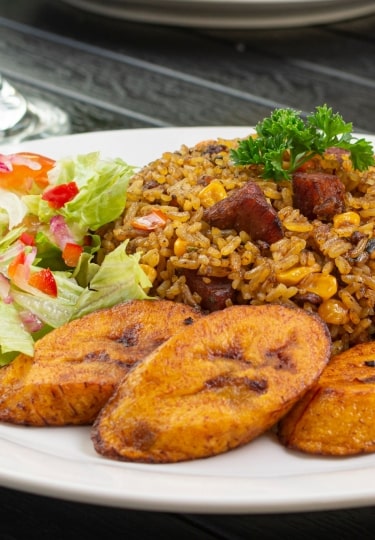The Dominican Republic’s food has many similarities to that of other countries in the Caribbean, particularly Cuba and Puerto Rico. That’s down to the shared Spanish origins, heavily influenced by African cuisine.
The original Tainos people, along with more recent immigrants from the Middle East, Asia and elsewhere, have also added their cooking to the mix. The result is a delightful, delicious blend, and some uniquely Dominican dishes.
From the lunchtime staple of La Bandera Dominicana to the sweet Quesillo dessert, you will enjoy a cuisine that is completely intertwined with national identity. Dominicans love their food, and you will too.
Here is a guide to some of the best Dominican food.
Plátanos

Plátanos
A staple of Caribbean cuisine, plantains (plátanos in Spanish) are as central to Quisqueyan (Dominican) identity as apple pie is to the USA. To call someone “aplatanado” is to say they are fully integrated into local culture.
These starchy fruits from the banana family are treated as a vegetable and cooked before eating. Unlike bananas, they can’t be eaten raw.
Like that other basic carb, potatoes, they can be boiled, fried, baked, grilled or steamed. Aguají, roasted plantain soup, is used as a cure-all for everything from a hangover to the flu.
Tostones
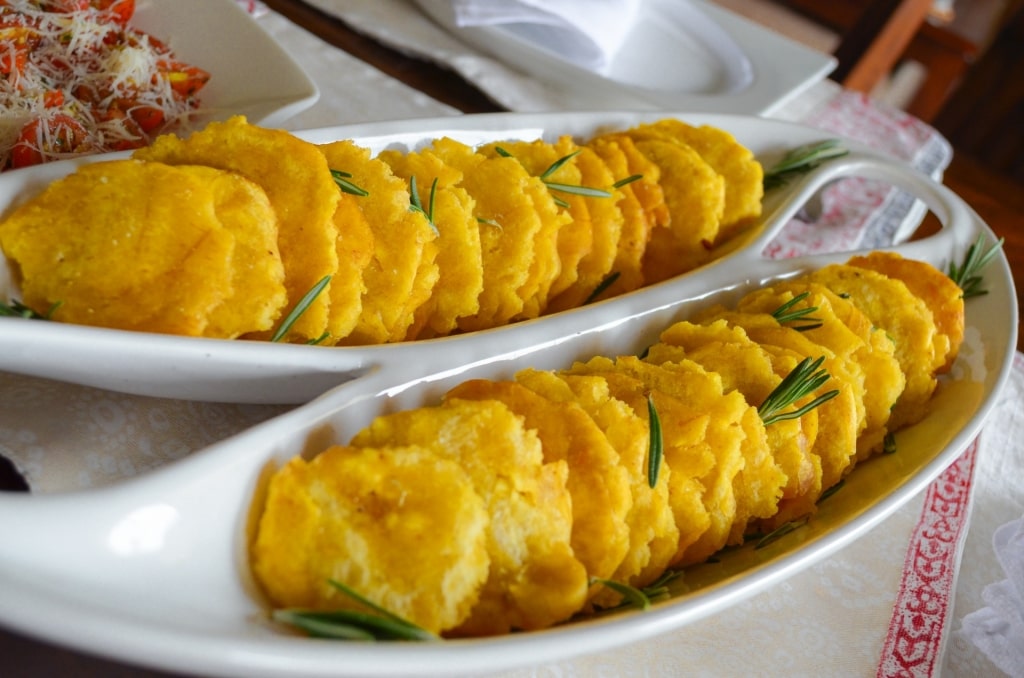
Tostones
The easiest description of tostones is a kind of French fry, but made of green plantains. Thick, one-inch slices are fried, pressed flat, then fried again to golden crispness.
Served fresh and liberally sprinkled with salt, they are a common side dish in restaurants and in roadside stalls. Like French fries, they are great with tomato sauce and/or mayonnaise.
Tostones are a good complement to dishes such as, well, anything you might eat with French fries. Fish, meat, a fried egg… what doesn’t taste better with some deep-fried carbs?
Bread
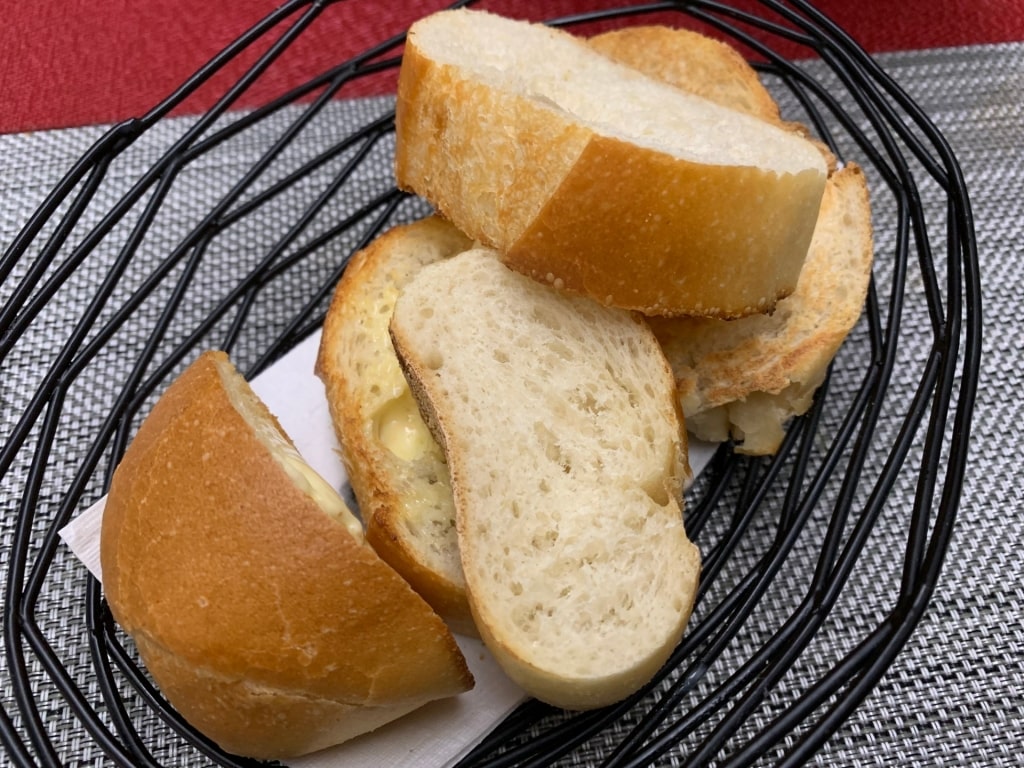
Bread
Many Dominicans start their day with pan de agua: bread rolls, crusty but with a soft center like a French baguette. You can even find them made in a mini-baguette style in bakeries or supermarkets.
They make a great, fast breakfast, eaten with hot chocolate, or coffee. A variation with egg is called pan de huevo, which is a bit lighter.
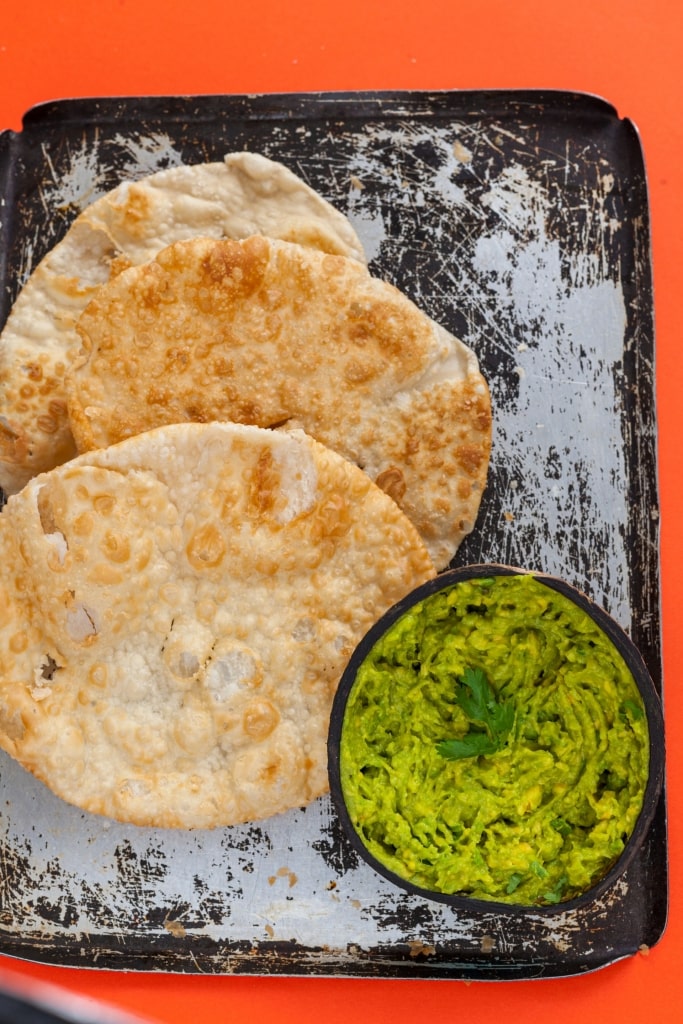
Yaniqueque
Yaniqueque is a fried bread which probably takes its name from the “johnny cakes” found throughout the Caribbean. It’s made with flour, butter and baking powder, shaped into flat rounds before frying.
Wheat is expensive to import, so the traditional alternative was cassava bread or casabe. It’s a healthy, crispy flatbread, with its roots in pre-Columbian society, and is as versatile as pitta bread.
Mangú

Mangú
Mangú is a dish of mashed plantains. Peeled and boiled, the plantains are then mashed like potatoes.
The mash is smoothed with a bit of water and fat, such as oil or butter. Seasoned with salt, it is then topped with cebolla roja con vinagre—sauteed red onions in vinegar.
You’ll find mangú on breakfast or brunch menus or as a side dish. In the morning, it’s often served with fried salami, fried eggs, and fried cheese.

Los tres golpes
This heart-stopping trio is known as “los tres golpes”—the three hits. Avocado can be added to make “los cuatro golpes”, just in case los tres golpes is too healthy for your taste.
You might be surprised to see salami being fried in los tres golpes. Think of it like bacon and it makes more sense to add that extra crispiness.
Every region in DR has its favorite salami brand, with fans having preferences for Induveca, Campesino or Checo salamis. Campesino mixes pork, turkey, and beef, for example, while Induveca is beef and pork, with a smoky flavor.
Farina
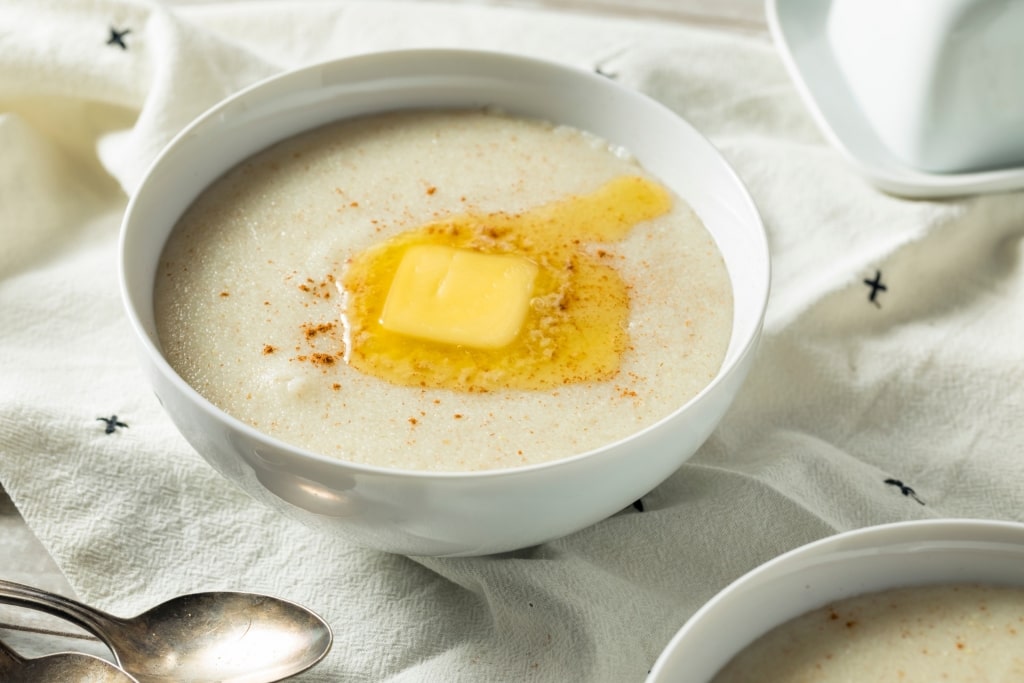
Farina
Mangú, and los tres golpes even more so, is typically seen as a good breakfast for those facing a hard day of work in the fields. A lighter option for children or office workers to start the day is a plate of farina, a cream of wheat porridge.
The most popular brand is “Cocimiento Rápido” Harina El Negrito, a fast-cooking porridge boiled up with milk. What makes it typically Quisqueyan is the addition of spices, namely cinnamon, clove and fresh nutmeg.
Farina can also be made with cornmeal or oatmeal. Either way, for Dominicans, it’s a quick, hot and tasty dish.
Pastelito/Catibía

Pastelito/Catibía
If you’re ever had an empanada, or Jamaican beef patty, you’ll recognize a pastelito as the delicious Dominican equivalent. It’s a deep-fried (or baked), half-moon, pastry parcel, usually containing meat.
Popular fillings are pork and chicken, but you’ll also find beef and cheese, or vegetable versions. A sugar-sprinkled version filled with fruit pulp such as guava makes a dessert.
If cassava flour (“catibía”) is substituted for wheat, the pastelito becomes the crispier catibía. Once a cheaper option for the poor, this cassava flour option has now been revisited with gourmet fillings such as lobster or shrimp.
Quipes
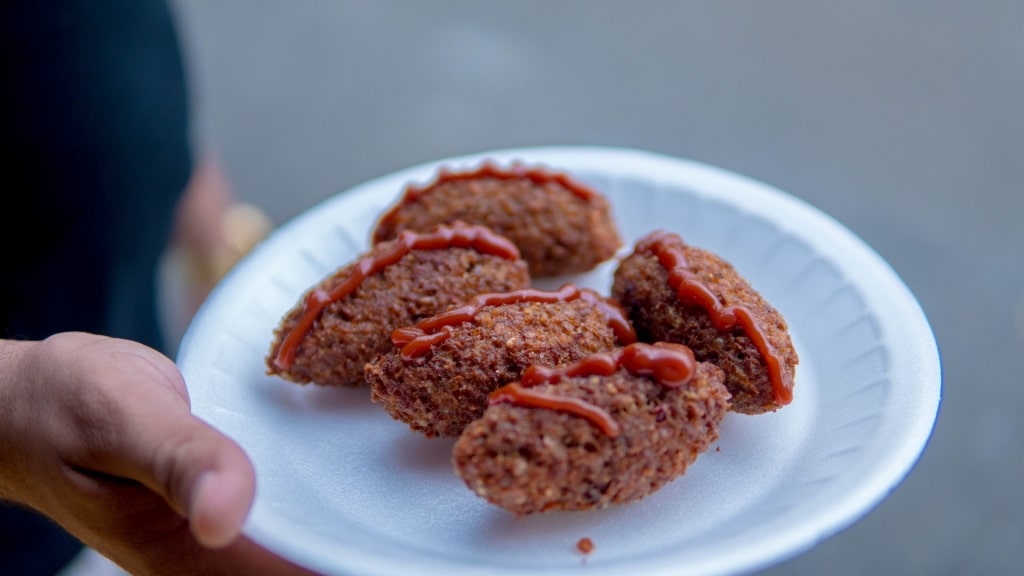
Quipes
A mid-1900s import from the Middle East, quipes (or kipes) are the local version of kibbeh. Ground beef (rather than the lamb of the original) is mixed with bulgur into a roll, stuffed with more ground beef or cheese, and deep fried.
Quipes may not be the healthiest of Dominican dishes, but they are hard to resist.
Niños envueltos

Niños envueltos
Another dish with Middle Eastern origins, “wrapped children” are scoops of rice and ground beef wrapped in cabbage. Cooked in tomato sauce, they’re served with bread to help sop up the juices.
La Bandera Dominicana
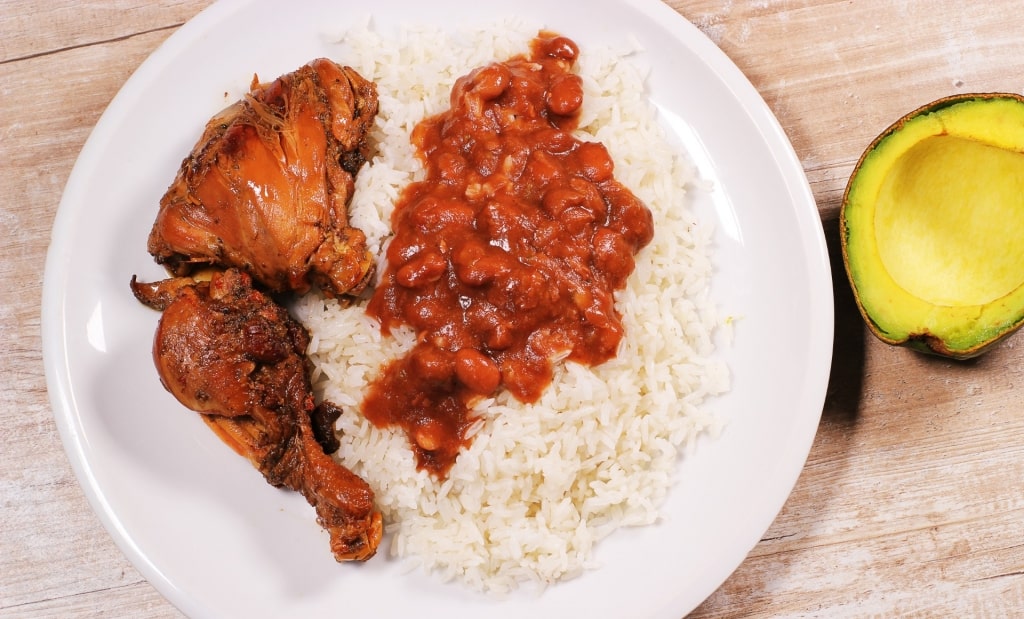
La Bandera Dominicana
“The Dominican Flag” is the name given to a meal of beans, rice and meat. It reflects the country’s tricolor, with its central white cross and corners of red and blue.
The red beans and white rice are an easy fit in this color scheme. The meat–usually braised chicken or beef—is a bit more of a stretch.
The whole reflects the importance of food to the country’s national identity. It’s recognized as the traditional dish of the Dominican Republic.
La Bandera Dominicana is the most common lunchtime meal and a dish that the Dominican Republic is known for. You’ll often see it simply called “plato del dia” on menus.
Along with the rice, beans and stew, expect to be served some fried plantain or a small side salad. Fish or pork can also substitute for the “pollo guisado” (braised chicken), or “res guisada (braised beef).
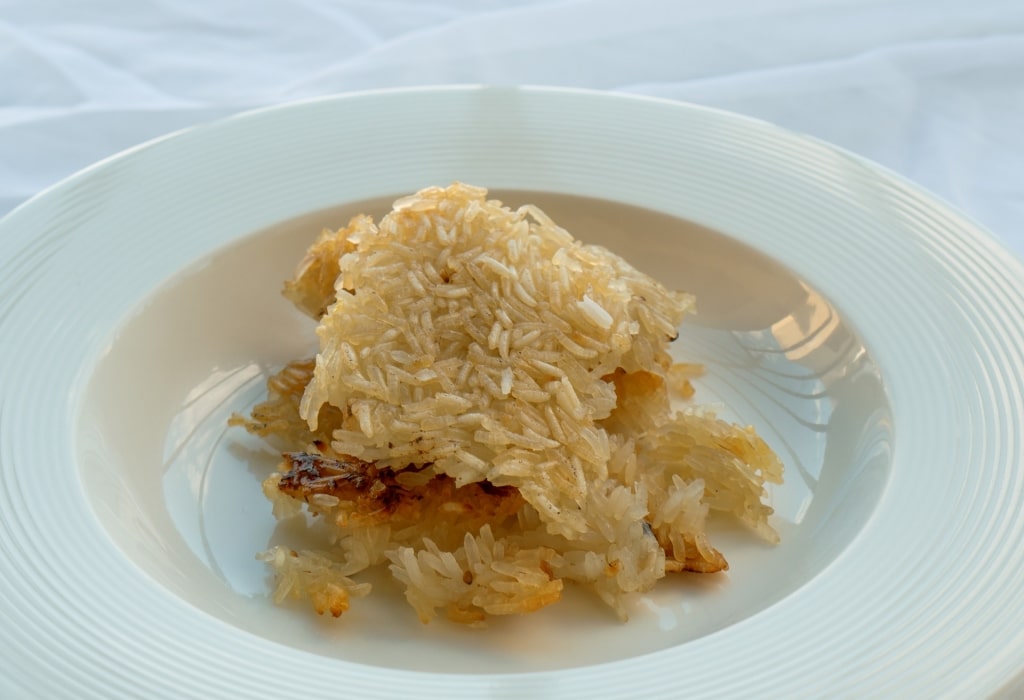
Concon
Incidentally, if you find some burnt rice on top of any dish in the Dominican Republic, you’ve just been served a local delicacy, concón. Like guoba in China, or tahdig in Iran, this crust of rice is prized for its taste and texture.
It’s made simply by adding some oil to the bottom of the rice cooker to crisp up the bottom layer. It’s sprinkled on as an extra flavoring or added to a sauce.
Mofongo
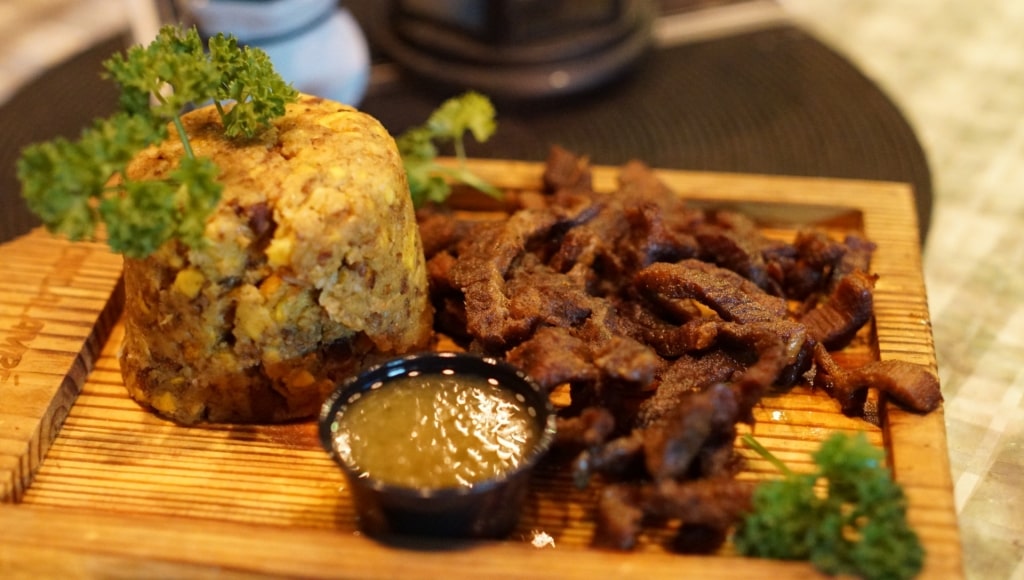
Mofongo
This is another Dominican staple, nowadays made with fried green plantains, but originally with grilled ones. The fried version seems to have reached DR from Puerto Rico, where it’s equally popular.
After frying, the plantains are mashed with fresh garlic and made into a ball. Chicharrón (fried pork rinds) is an essential component as well, either in the mixture or alongside.
Mofongo is served with a broth or sauce as a main course, side dish, or evening snack. It’s a simple dish, but has complex flavors, and one every Quisqueya cook prides themselves on.
Read: Dominican Republic vs. Puerto Rico: Which Should You Visit?
Mondongo
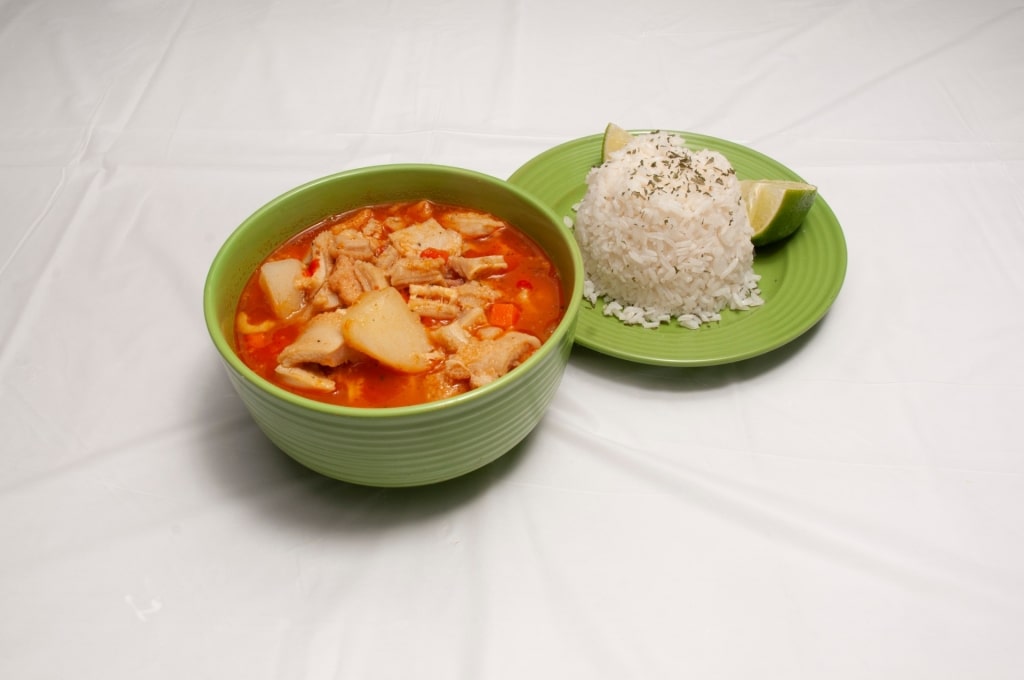
Mondongo
If offal is not to your taste, you’ll not want to confuse mondongo with mofongo. Mondongo is a stew made with beef, cow, pig, or goat tripe.
Some travelers will already know it as chitterlings, or chitlins. It’s tough meat, and needs lengthy stewing with vegetables, herbs, lots of seasoning, and maybe some tomatoes.
Mondongo is comfort food, the first thing many Dominicans will want when coming home. Another dish with similar roots is pico y pala (“pick and shovel”), which is a stew with tough chicken parts such as feet and necks.
Fish
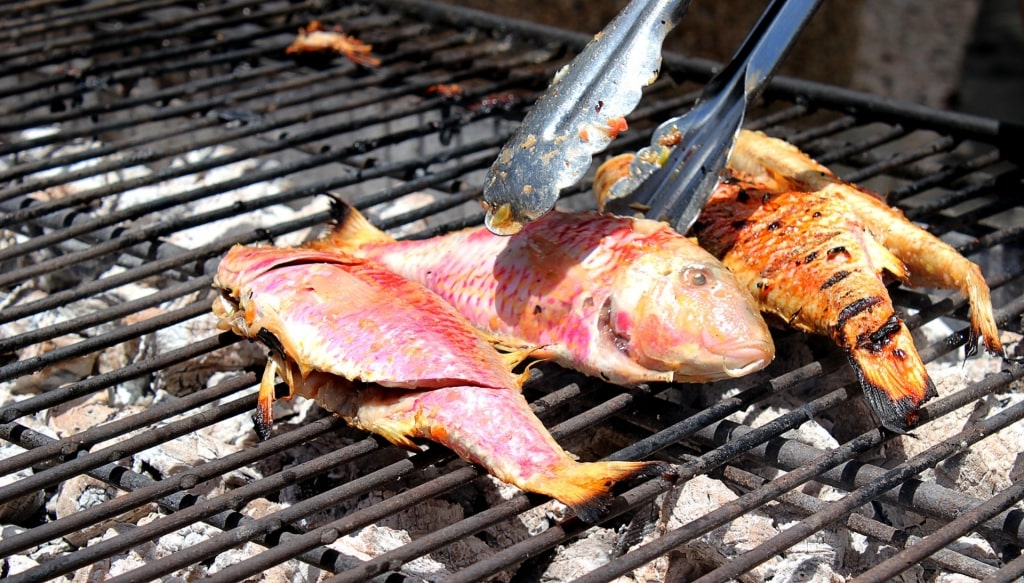
Grilled fish
Despite the country being an island, the traditional menu in the Dominican Republic is surprisingly light on fish. At some of the Dominican Republic’s beaches, however, you will easily find simple grilled fish, or pescado con coco (fish in coconut sauce).
Locrio de Arenque (rice and smoked herrings) is a risotto-like dish—once considered the food of the poor. The herring is soaked for a few hours, then fried with a sazón before being simmered with rice.
Just like a sofrito in Italian cooking, a sazón is a particular cook’s base for many Dominican dishes. It’s a mix of finely diced onion, garlic, green pepper, and tomato, flavored with herbs (such as parsley and coriander) and vinegar.
Pastelón de Plátano Maduro

Pastelón de Plátano Maduro
“Ripe Plantain Casserole” is a lasagna-style dish made with layers of plantain, meat and cheese. It’s hearty and is second only to mangú in popularity for cooking plantains.
Ripe plantains are boiled, then mashed to a smooth pulp with butter. This is then layered with cheese and ground beef with onion and tomato sauce before baking.
Guisada
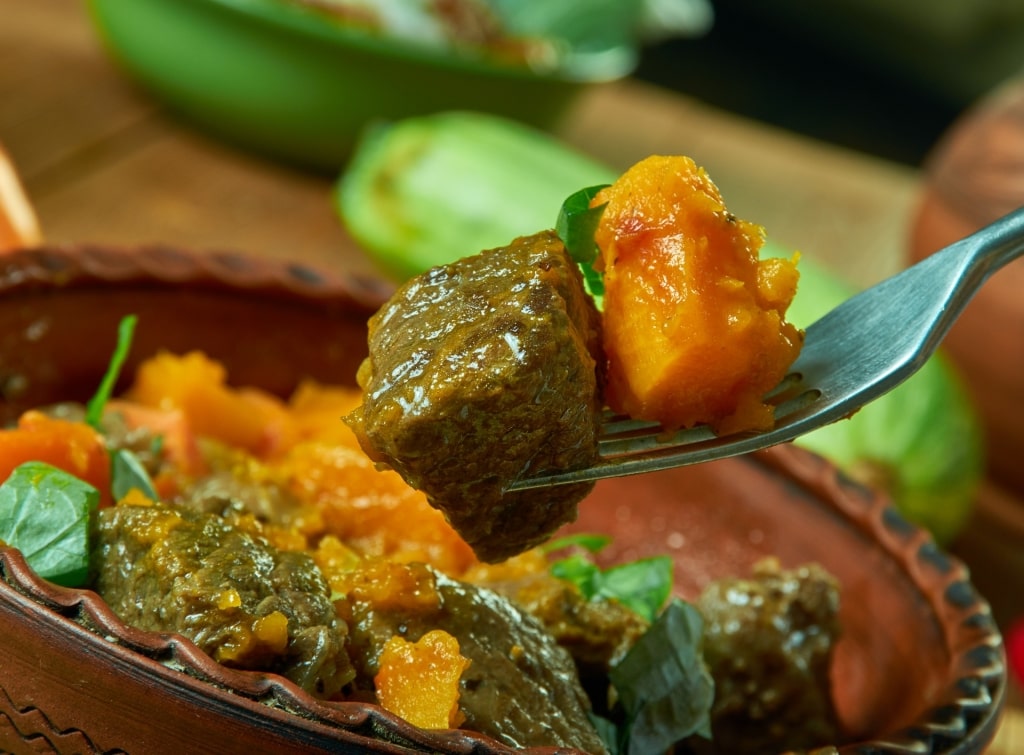
Carne guisada
Carne guisada is a traditional beef stew, slow-cooked with onions and peppers such as jalapeños or Scotch bonnet. There’s also pollo guisado, with chicken, and chivo guisado, with goat.
As you can imagine, goat was the more traditional ingredient but increasing prosperity has made beef a substitute. Goat, fed on wild oregano, still adds an extra flavor to the stew,
The stew is served on tortillas, or with rice or potato. It is also good with chenchén, a cornmeal polenta.
Chapea/chambre
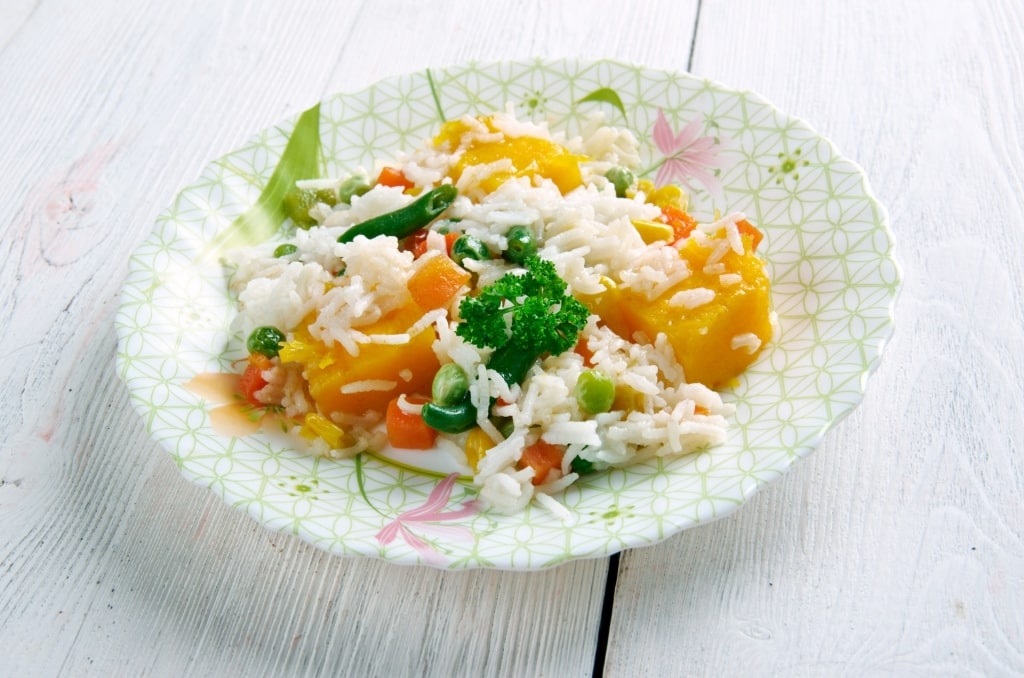
Chapea/chambre
This is a stew of beans, rice, vegetables, and, of course, plantains. Flavoring comes from coriander and sour orange or lime juice, as well as peppers and garlic.
The dish is usually made with a base of sausage or other pork—and/or they can be served on the side. A common topping is sliced avocado. Vegetarians could opt for the avocado option and leave out the meat.
Sancocho
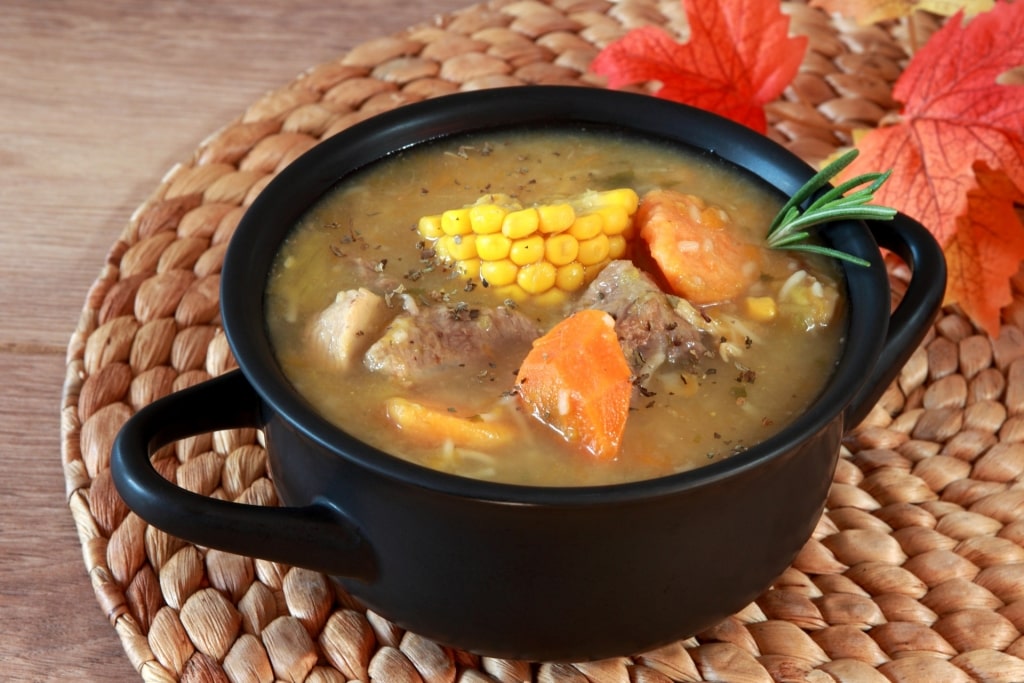
Sancocho
Another great Dominican food is sancocho—a stew with almost everything in it. Everything being potatoes, plantains, yam and yucca, beef, pork and chicken… You get the idea.
It’s hearty and full of flavoring from garlic, herbs, vinegar and “naranja agria” (sour orange), or lemon. As you might expect, it doesn’t need much in the way of accompaniments: plain rice and sliced avocado.
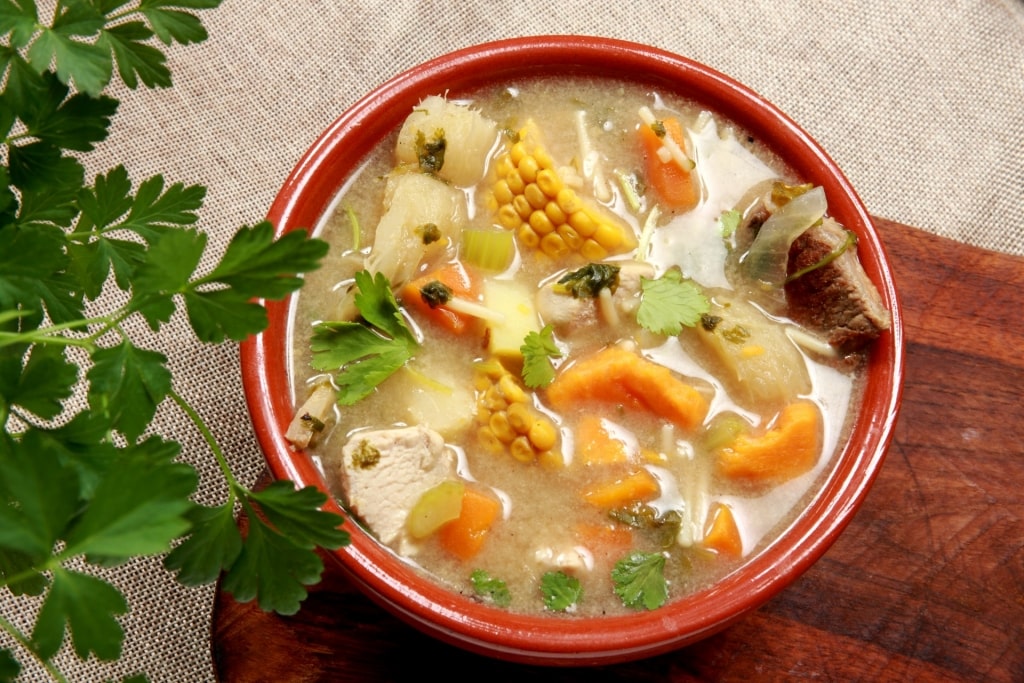
Sancocho de siete carnes
An even heartier version, sancocho de siete carnes, is made for special occasions, such as New Year’s Eve or Sunday dinner. The “seven meats” in its name are beef, goat, pork, pork ribs, pork sausage, chicken, and smoked ham bones.
Read: Best Things to Do in Puerto Plata
Chicharrón

Chicharrón
Stalls selling these fried pork rinds can be seen everywhere on the roadside in DR. The aroma is hard to escape as you walk or even drive past, making your mouth water if you’re a fan.
If you’re from America’s Deep South, or from the UK, you’ll recognize it as crackling (or “cracklins”). However, there’s no doubt this fatty, greasy snack is an acquired taste.
For those who don’t eat pork, you can find a variation with chicken. Both are served from stalls, sometimes with sides such as boiled yucca or guineito (green banana, often boiled with peppers and onions).
Chimichurri Burger
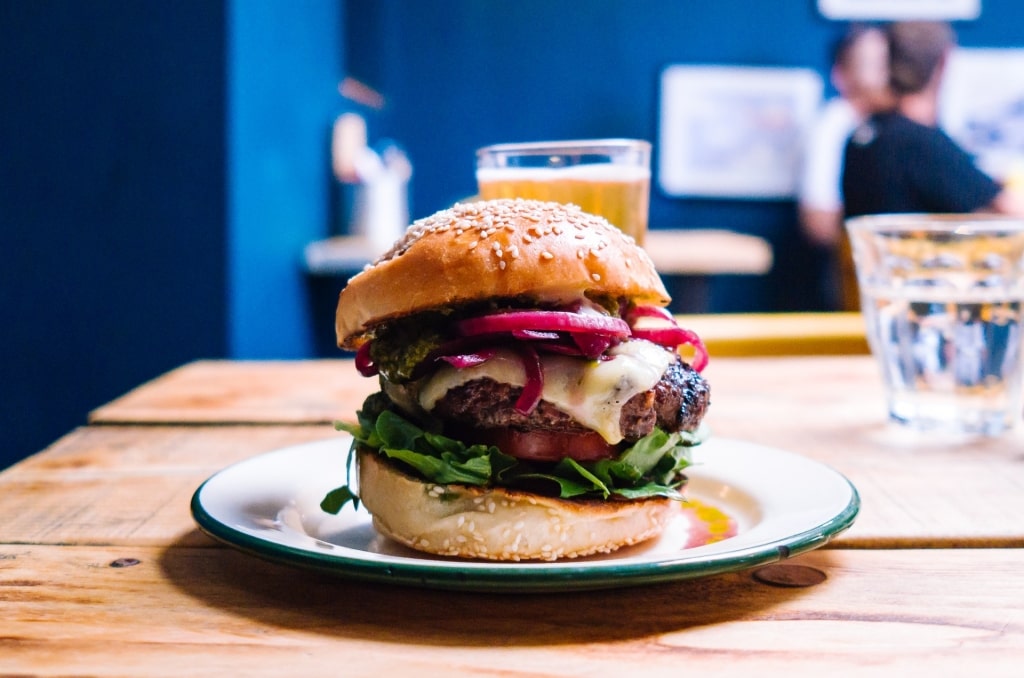
Chimichurri burger
You may be familiar with chimichurri from Argentina or Uruguay. It’s a sauce made with parsley, garlic, and onion, with a few other ingredients depending on the cook.
A chimichurri burger is a local favorite, made with a topping of shredded cabbage (not lettuce) and never with cheese. It’s served in a soft “pan de agua” bun with lots of chimichurri.
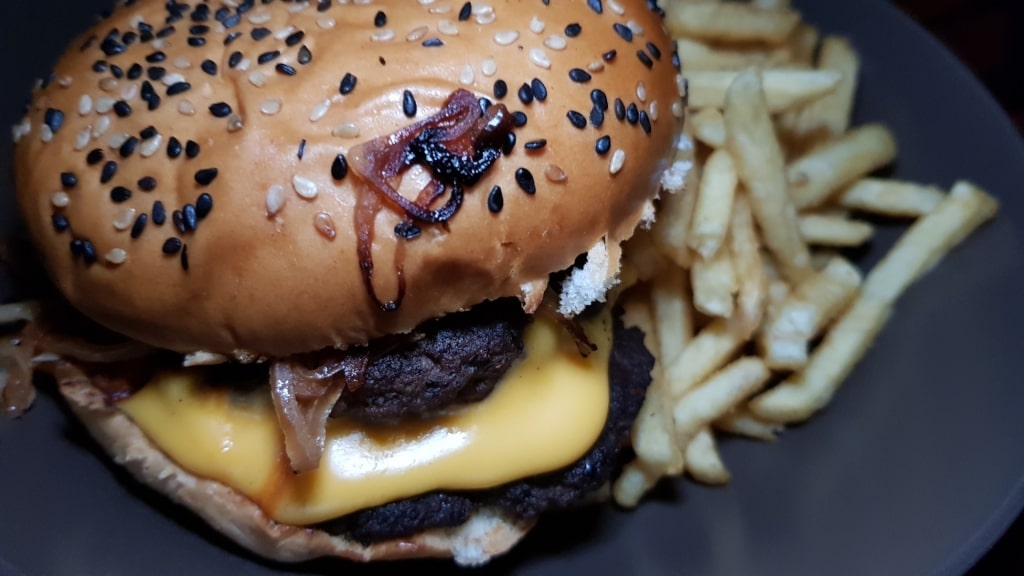
Chimichurri burger
The sauce may have arrived with an Argentine immigrant chef but was quickly picked up by Quisqueyans as their own. You’ll now find “chimi” for sale everywhere, popular as a quick, cheap meal.
Yaroa
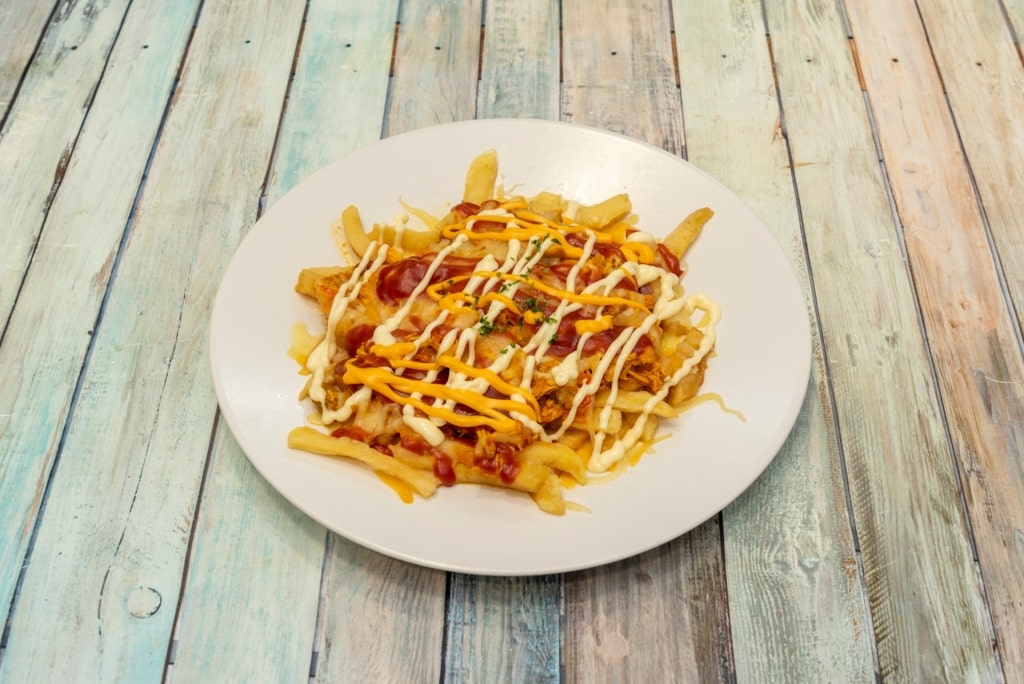
Yaroa
If you’re a Canadian missing your poutine, you’re in luck with yaroa de papa frita. This recent arrival on the Dominican fast food scene is a similar mound of spicy ground beef, french fries and melted cheese.
Yaroa de plátano maduro substitutes mashed plantains for the french fries. Obviously, for either version, you need to add mayo and lots of tomato sauce to complete the picture.
Flan/Quesillo
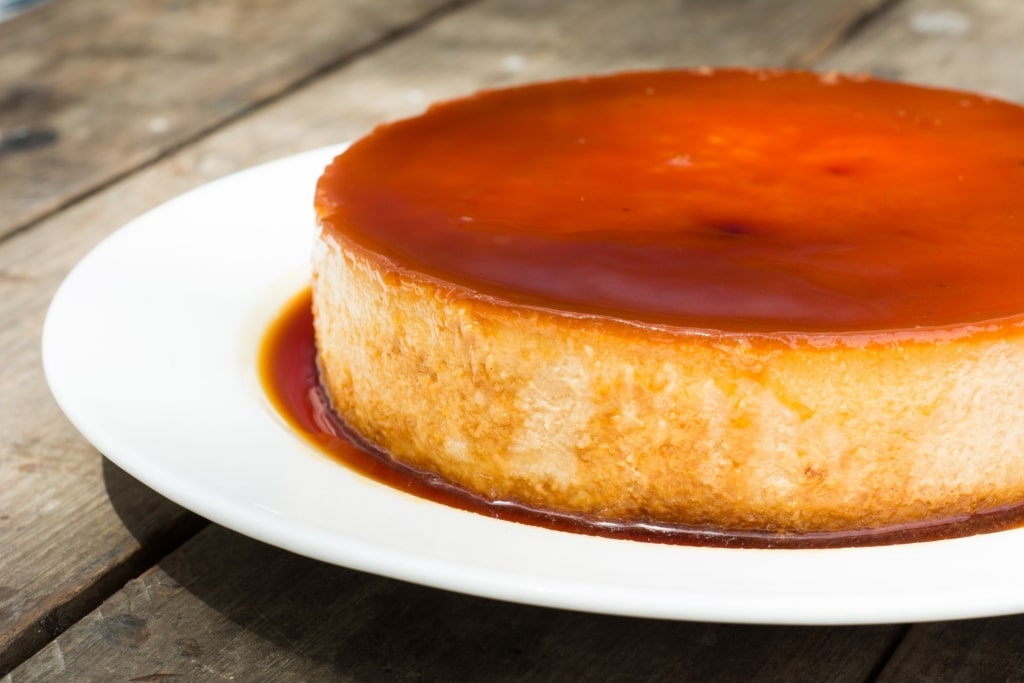
Flan/quesillo
Flan is a crème caramel, and a dessert you’ll find on almost every restaurant menu in the Dominican Republic. As one of the best desserts in the world, it’s also common throughout Latin America, and in Spain.
Quesillo (“little cheese”) is a common name for any variation of flan not based on vanilla. Popular choices for a quesillo include coconut, lemon or orange, and passion fruit.
Habichuelas con Dulce
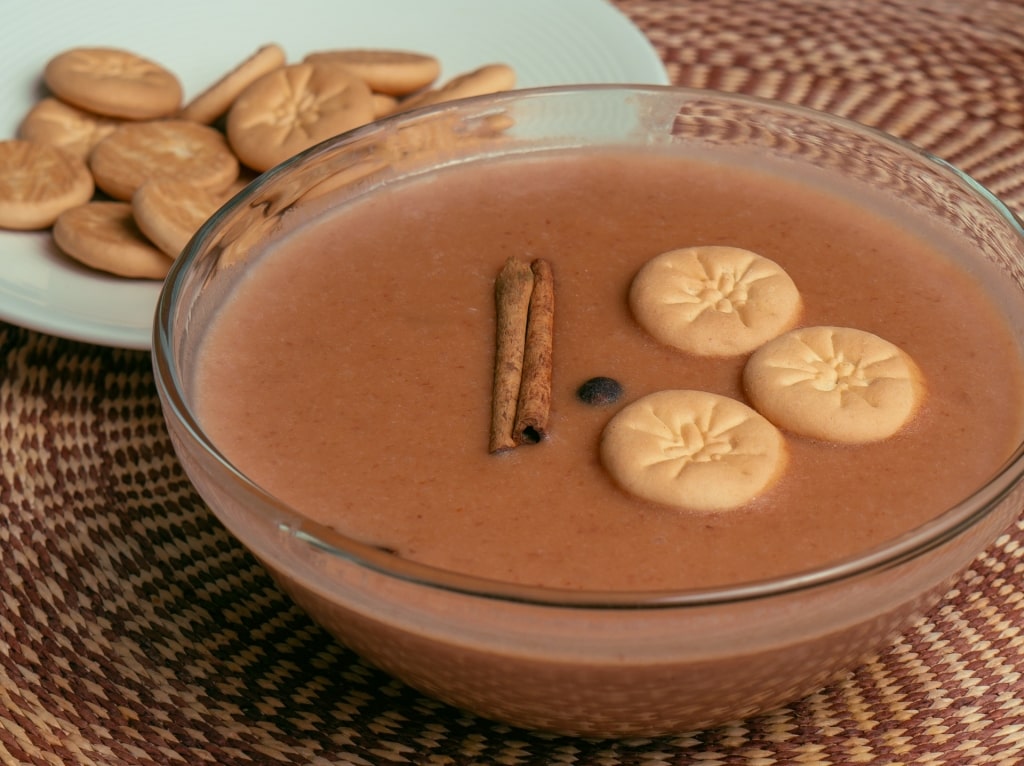
Habichuelas con Dulce
Possibly having Turkish or African roots, this is a soup-like sweet dessert made from red kidney beans. It’s a tradition during Lent and Easter Week, but is found year-round in supermarkets or pastry shops.
It’s made from coconut milk and condensed milk, in which you boil the pre-soaked and puréed beans. Sugar, cinnamon, cloves, vanilla, sweet potato chunks or raisins add extra flavors before it’s topped with milk cookies.
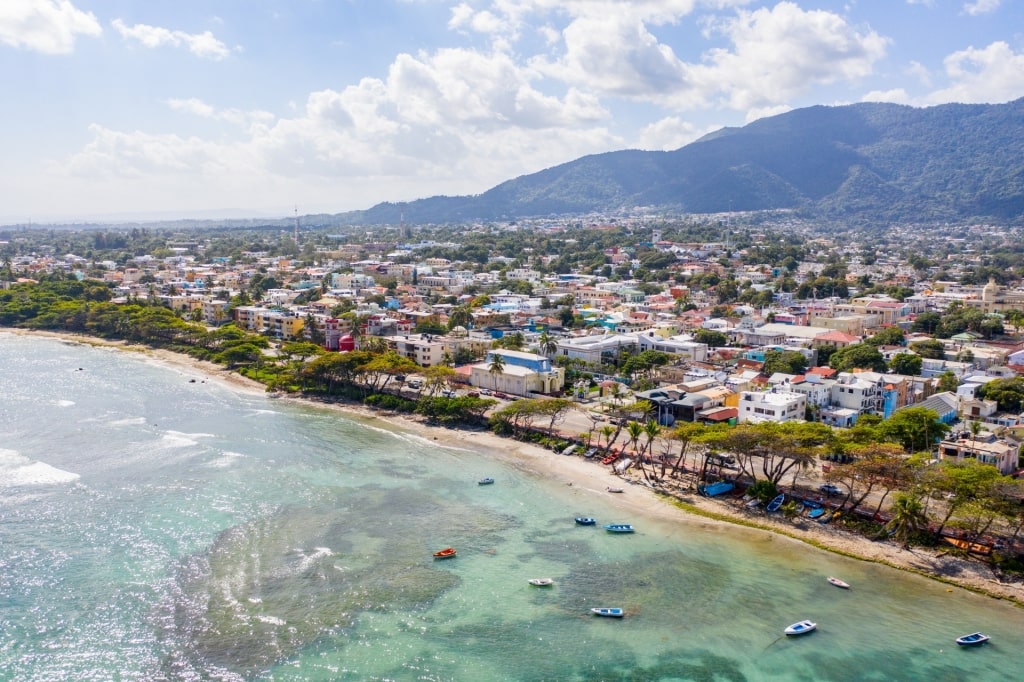
Puerto Plata
Has this taste of the best food from the Dominican Republic sharpened your appetite for a visit to the island? Then browse our cruises to Puerto Plata to find an itinerary that will take you to this lovely Caribbean nation.
